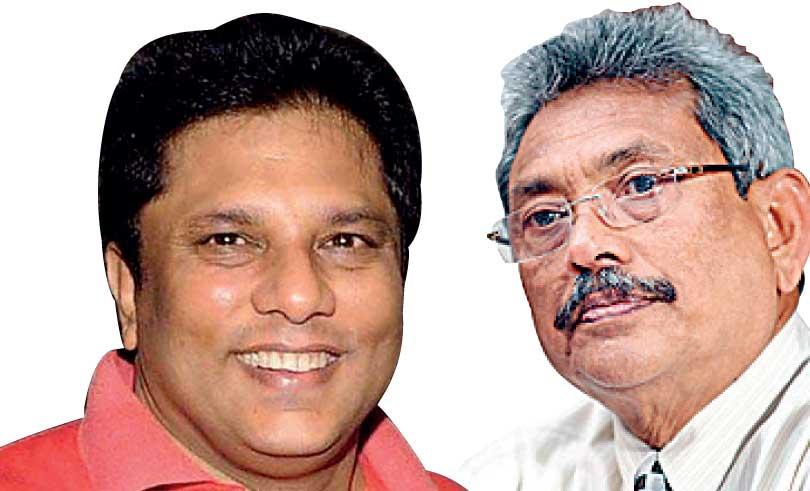Reply To:
Name - Reply Comment

 Perhaps, the most important event that would define Sri Lanka’s presidential race, and possibly also the future of Sri Lankan politics, happened at a parking lot of an American grocery chain, Trader Joe’s in Pasadena, California last week.
Perhaps, the most important event that would define Sri Lanka’s presidential race, and possibly also the future of Sri Lankan politics, happened at a parking lot of an American grocery chain, Trader Joe’s in Pasadena, California last week.
Gotabaya Rajapaksa, the presidential hopeful of the joint opposition and onetime strong man defence secretary was served summons in two civil action cases filed by Ahimsa Wickrematunge, the daughter of the slain editor of Sunday Leader, Lasantha Wickrematunge and Roy Samathanam, an alleged Tamil torture survivor who was detained under the Prevention of Terrorism Act for three years from 2007 to 2010, during which, he said he was tortured and forced to sign a false confession.
Mr. Rajapaksa who has announced his presidential ambitions had travelled to the United States to renounce his American citizenship. However, while he was visiting his supporters in Nevada, out of the blue came what many might have anticipated: Private investigators of two American firms that had been tasked with serving papers to Mr. Rajapaksa tracked him down to the grocery chain. He was photographed as accepting the sealed brown envelope containing the summons (According to the procedure governing civil lawsuits in the USA, the plaintiff is also responsible for formally delivering the complaint to the defendant).
The two cases are said to be handled by Scott Gilmore, an international human rights lawyer who earlier won a record, but symbolic court ruling of USD 300 million compensation on behalf of the family of journalist Marie Colvin, against the Syrian Government for the alleged role of Syrian State forces in precision bombing to kill the late journalist of the Sunday Times London.
An American civil lawsuit goes through several stages before it enters trial.
Accordingly, the next course of action would be for Mr. Rajapaksa to respond to the two lawsuits, which he has said he would do in the coming weeks. A ‘response’ will typically detail the defendant’s description of the events that lead to the dispute, outlining any inaccuracies or falsehoods that they find in the complaint. Mr. Rajapaksa can also file a counter-claim if he chooses.
The pertinent question as per Mr. Rajapaksa is whether the process to renounce his American citizenship would be put on hold until the court reaches a verdict on the two lawsuits filed against him
Once the two parties complete the pleading process, the civil lawsuit would enter the second stage of discovery, where the two parties could obtain information on the content of the lawsuit through demand for information from each other. The objective of this phase is to enable both sides to enter the trial with as much information as possible.
After the phase of discovery is concluded and if the case if not settled out of court, the civil lawsuit will enter its third stage and proceed to trial. At the trial, the defendant and plaintiff would first present a brief outlining their position on the case, and subsequently their arguments, and rebuttals to the judge or a jury.
Once each party has had an opportunity to present its case, both will make a closing argument. In a jury trial, after closing arguments, the judge would instruct the jury on the legal basis that it should apply to the evidence. The jury deliberates for a period of time until a verdict is reached.
In a bench trial, the judge deliberates for a period of time until a decision or verdict is reached.
After the verdict is made, a party can choose to challenge the verdict. Similarly, a party can also file a motion for a new trial.
The process of civil lawsuit is thus time-consuming. The pertinent question as per Mr. Rajapaksa is whether the process to renounce his American citizenship would be put on hold until the court reaches a verdict on the two lawsuits filed against him.
According to the Immigration and Nationality Act of the United State, “the act of renouncing US citizenship does not allow persons to avoid possible prosecution for crimes which they may have committed or may commit in the future which violate the United States law, or escape the repayment of financial obligations, including child support payments, previously incurred in the United States or incurred as United States citizens abroad.”
Thus effectively, Mr. Rajapaksa cannot escape the course of justice should the US courts take up the two cases against him. The act, however, does not outlines the procedure that would apply when there is a pending or ongoing lawsuit against an American citizen who applies to revoke his or her American citizenship.
The logical expectation would be that they would have to wait till the court decided on its verdict.
After embarrassing events in America, Mr. Rajapaksa returned to Sri Lanka last week to a jubilant crowd of coterie. In Colombo, he was quoted as saying steps needed for his renouncing of American citizenship were successfully concluded during his visit.
According to the American Immigration and Nationality Act, “a person wishing to renounce his or her US citizenship must voluntarily and with intent to relinquish US citizenship: appear in person before a US consular or diplomatic officer, in a foreign country at a US embassy or consulate; and sign an oath of renunciation.”
That would mean Mr. Rajapaksa would have to file his papers at the American embassy in Colombo, which he has said he was planning to do in the coming weeks.
The two lawsuits could become a public relations disaster not only for Mr. Rajapaksa, but also for Sri Lanka as a whole
However, in many accounts, he is running against time. While the renunciation of American citizenship may be a pretty straightforward process, Mr. Rajapaksa’s contentious past track record as the all-powerful defence secretary who decided the life and death of the critics of the then government is surely complicating the process.
Perhaps, the bigger worry for Mr. Rajapaksa and his lawyers should be that this could well be the beginning of something bigger. Now that two victims had taken the lead, floodgates would soon be open as more aggrieved parties rush to America to seek justice. The list would be as wide as the relatives of the victims of the 2012 Welikada prison massacre, journalists, civil society activists and innocent Tamils. Some information that would be revealed in American courts would be troubling. As some survivors of the Welikada prison massacre have alleged, victims had been picked from their cells for slaughter based on a list known as “Gota’s list.” The government has refused to make public the report of the presidential inquiry into the prison massacre. While some prison and police officers have been arrested and remanded, investigations have failed to hold into account those who held command responsibility of the incident.
However, the flip side of all of that is it would also diminish the legitimacy of Sri Lankan courts in the eyes of the international community. Selective application of justice through domestic investigations also raises serious questions about political interference, and an unholy nexus among the political leadership of the old regime and the present, and the law enforcement apparatus in shielding certain interested parties from prosecution.
The two lawsuits could become a public relations disaster not only for Mr. Rajapaksa, but also for Sri Lanka as a whole. The government should brace itself to face any eventuality.